Analysis of Numerical Artifacts Using Tetrahedral Meshes in Low Frequency Numerical Dosimetry
Abstract
1. Introduction
2. Numerical Formulation
3. Tetrahedral Mesh Quality
4. Dosimetric Models
4.1. Multilayered Sphere
4.2. Human Head—Anatomical 3D Model
4.3. Human Head—Simplified 3D Models
5. Numerical Results
5.1. Multilayered Sphere
5.2. Human Head—Simplified 3D Model
5.3. Human Head—Complete 3D Model
6. Conclusions
Author Contributions
Funding
Institutional Review Board Statement
Informed Consent Statement
Data Availability Statement
Conflicts of Interest
References
- Reilly, J.P.; Hirata, A. Low-frequency electrical dosimetry: Research agenda of the IEEE International Committee on Electromagnetic Safety. Phys. Med. Biol. 2016, 61, R138–R149. [Google Scholar] [CrossRef] [PubMed]
- Hirata, A.; Diao, Y.; Onishi, T.; Sasaki, K.; Ahn, S.; Colombi, D.; De Santis, V.; Laakso, I.; Giaccone, L.; Joseph, W.; et al. Assessment of Human Exposure to Electromagnetic Fields: Review and Future Directions. IEEE Trans. Electromagn. Compat. 2021, 63, 1619–1630. [Google Scholar] [CrossRef]
- Diao, Y.; Gomez-Tames, J.; Rashed, E.A.; Kavet, R.; Hirata, A. Spatial Averaging Schemes of In Situ Electric Field for Low-Frequency Magnetic Field Exposures. IEEE Access 2019, 7, 184320–184331. [Google Scholar] [CrossRef]
- Christ, A.; Kainz, W.; Hahn, E.; Honegger, K.; Zefferer, M.; Neufeld, E.; Rascher, W.; Janka, R.; Bautz, W.; Chen, J.; et al. The Virtual Family – development of surface-based anatomical models of two adults and two children for dosimetric simulations. Phys. Med. Biol. 2010, 55, 23–38. [Google Scholar] [CrossRef]
- Lin, J.; Saunders, R.; Schulmeister, K.; Soderberg, P.; Stuck, B.E.; Taki, M.; Veyret, B.; Ziegelberger, G.; Swerdlow, A.; Repacholi, M.H.; et al. ICNIRPGuidelines for limiting exposure to time-varying electric and magnetic fields (1 Hz–100 kHz). Health Phys. 2010, 99, 818–836. [Google Scholar] [CrossRef]
- Gomez-Tames, J.; Laakso, I.; Haba, Y.; Hirata, A.; Poljak, D.; Yamazaki, K. Computational Artifacts of the In Situ Electric Field in Anatomical Models Exposed to Low-Frequency Magnetic Field. IEEE Trans. Electromagn. Compat. 2018, 60, 589–597. [Google Scholar] [CrossRef]
- Arduino, A.; Bottauscio, O.; Chiampi, M.; Giaccone, L.; Liorni, I.; Kuster, N.; Zilberti, L.; Zucca, M. Accuracy Assessment of Numerical Dosimetry for the Evaluation of Human Exposure to Electric Vehicle Inductive Charging Systems. IEEE Trans. Electromagn. Compat. 2020, 1–12. [Google Scholar] [CrossRef]
- Siauve, N.; Nicolas, L.; Vollaire, C.; Nicolas, A.; Vasconcelos, J. Optimization of 3-D SAR distribution in local RF hyperthermia. IEEE Trans. Mag. 2004, 40, 1264–1267. [Google Scholar] [CrossRef]
- Scorretti, R.; Burais, N.; Fabregue, O.; Nicolas, A.; Nicolas, L. Computation of the Induced Current Density Into the Human Body Due to Relative LF Magnetic Field Generated by Realistic Devices. IEEE Trans. Mag. 2004, 40, 643–646. [Google Scholar] [CrossRef]
- Scorretti, R.; Burais, N.; Nicolas, L.; Nicolas, A. Modeling of induced current into the human body by low-frequency magnetic field from experimental data. IEEE Trans. Mag. 2005, 41, 1992–1995. [Google Scholar] [CrossRef]
- Scorretti, R.; Sabariego, R.V.; Morel, L.; Geuzaine, C.; Burais, N.; Nicolas, L. Computation of Induced Fields Into the Human Body by Dual Finite Element Formulations. IEEE Trans. Mag. 2012, 48, 783–786. [Google Scholar] [CrossRef][Green Version]
- Fang, Q.; Boas, D.A. Tetrahedral mesh generation from volumetric binary and grayscale images. In Proceedings of the 2009 IEEE International Symposium on Biomedical Imaging: From Nano to Macro, Boston, MA, USA, 28 June–1 July 2009; pp. 1142–1145. [Google Scholar]
- Lelong, T.; Tang, Z.; Scorretti, R.; Thomas, P.; Le Menach, Y.; Creusé, E.; Piriou, F.; Burais, N.; Miry, C.; Magne, I. Error estimation in the Computation of Induced Current of Human Body in the Case of Low frequency Magnetic Field Excitation. In Proceedings of the Compumag 2013, Budapest, Hungary, 30 June–4 July 2013; p. PC1-11. [Google Scholar]
- Hoang, L.H.; Scorretti, R.; Burais, N.; Voyer, D. Numerical Dosimetry of Induced Phenomena in the Human Body by a Three-Phase Power Line. IEEE Trans. Mag. 2009, 45, 1666–1669. [Google Scholar] [CrossRef]
- Soldati, M.; Laakso, I. Computational errors of the induced electric field in voxelized and tetrahedral anatomical head models exposed to spatially uniform and localized magnetic fields. Phys. Med. Biol. 2020, 65, 015001. [Google Scholar] [CrossRef] [PubMed]
- Dawson, T.; Stuchly, M. Analytic validation of a three-dimensional scalar-potential finite-difference code for low-frequency magnetic induction. Appl. Comput. Electrom. 1996, 11, 72–81. [Google Scholar]
- So, P.; Stuchly, M.; Nyenhuis, J. Peripheral nerve stimulation by gradient switching fields in magnetic resonance imaging. IEEE Trans. Biomed. Eng. 2004, 51, 1907–1914. [Google Scholar] [CrossRef]
- Dimbylow, P. Development of the female voxel phantom, NAOMI, and its application to calculations of induced current densities and electric fields from applied low frequency magnetic and electric fields. Phys. Med. Biol. 2005, 50, 1047–1070. [Google Scholar] [CrossRef]
- Hirata, A.; Takano, Y.; Kamimura, Y.; Fujiwara, O. Effect of the averaging volume and algorithm on the in situ electric field for uniform electric- and magnetic-field exposures. Phys. Med. Biol. 2010, 55, N243–N252. [Google Scholar] [CrossRef]
- Canova, A.; Freschi, F.; Giaccone, L.; Repetto, M. Exposure of working population to pulsed magnetic fields. IEEE Trans. Magnet. 2010, 46, 2819–2822. [Google Scholar] [CrossRef]
- Zoppetti, N.; Andreuccetti, D.; Bellieni, C.; Bogi, A.; Pinto, I. Evaluation and characterization of fetal exposures to low frequency magnetic fields generated by laptop computers. Progress Biophys. Mol. Biol. 2011, 107, 456–463. [Google Scholar] [CrossRef]
- Laakso, I.; Hirata, A. Reducing the staircasing error in computational dosimetry of low-frequency electromagnetic fields. Phys. Med. Biol. 2012, 57, N25–N34. [Google Scholar] [CrossRef]
- Canova, A.; Freschi, F.; Giaccone, L.; Manca, M. A Simplified Procedure for the Exposure to the Magnetic Field Produced by Resistance Spot Welding Guns. IEEE Trans. Magn. 2016, 52, 1–4. [Google Scholar] [CrossRef]
- Freschi, F.; Giaccone, L.; Cirimele, V.; Canova, A. Numerical assessment of low-frequency dosimetry from sampled magnetic fields. Phys. Med. Biol. 2018, 63, 015029. [Google Scholar] [CrossRef] [PubMed]
- Notay, Y. AGMG. Version 3.3.5. 2022. Available online: http://agmg.eu/ (accessed on 24 June 2022).
- Notay, Y. An aggregation-based algebraic multigrid method. Electron. Trans. Numer. Anal. 2010, 37, 123–146. [Google Scholar]
- Napov, A.; Notay, Y. An Algebraic Multigrid Method with Guaranteed Convergence Rate. SIAM J. Sci. Comput. 2012, 34, A1079–A1109. [Google Scholar] [CrossRef]
- Notay, Y. Aggregation-Based Algebraic Multigrid for Convection-Diffusion Equations. SIAM J. Sci. Comput. 2012, 34, A2288–A2316. [Google Scholar] [CrossRef]
- Field, D.A. Qualitative measures for initial meshes. Int. J. Numer. Methods Eng. 2000, 47, 887–906. [Google Scholar] [CrossRef]
- Collins, D.L.; Zijdenbos, A.P.; Kollokian, V.; Sled, J.G.; Kabani, N.J.; Holmes, C.J.; Evans, A.C. Design and construction of a realistic digital brain phantom. IEEE Trans. Med. Imaging 1998, 17, 463–468. [Google Scholar] [CrossRef]
- Fang, Q. Mesh-based Monte Carlo method using fast ray-tracing in Plucker coordinates. Biomed. Opt. Express 2010, 1, 165–175. [Google Scholar] [CrossRef]
- Colin27 Adult Brain Atlas FEM Mesh. Available online: http://mcx.space/wiki/index.cgi?MMC/Colin27AtlasMesh (accessed on 24 June 2022).
- Chen, X.L.; Benkler, S.; Chavannes, N.; Santis, V.D.; Bakker, J.; van Rhoon, G.; Mosig, J.; Kuster, N. Analysis of human brain exposure to low-frequency magnetic fields: A numerical assessment of spatially averaged electric fields and exposure limits. Bioelectromagnetics 2013, 34, 375–384. [Google Scholar] [CrossRef]
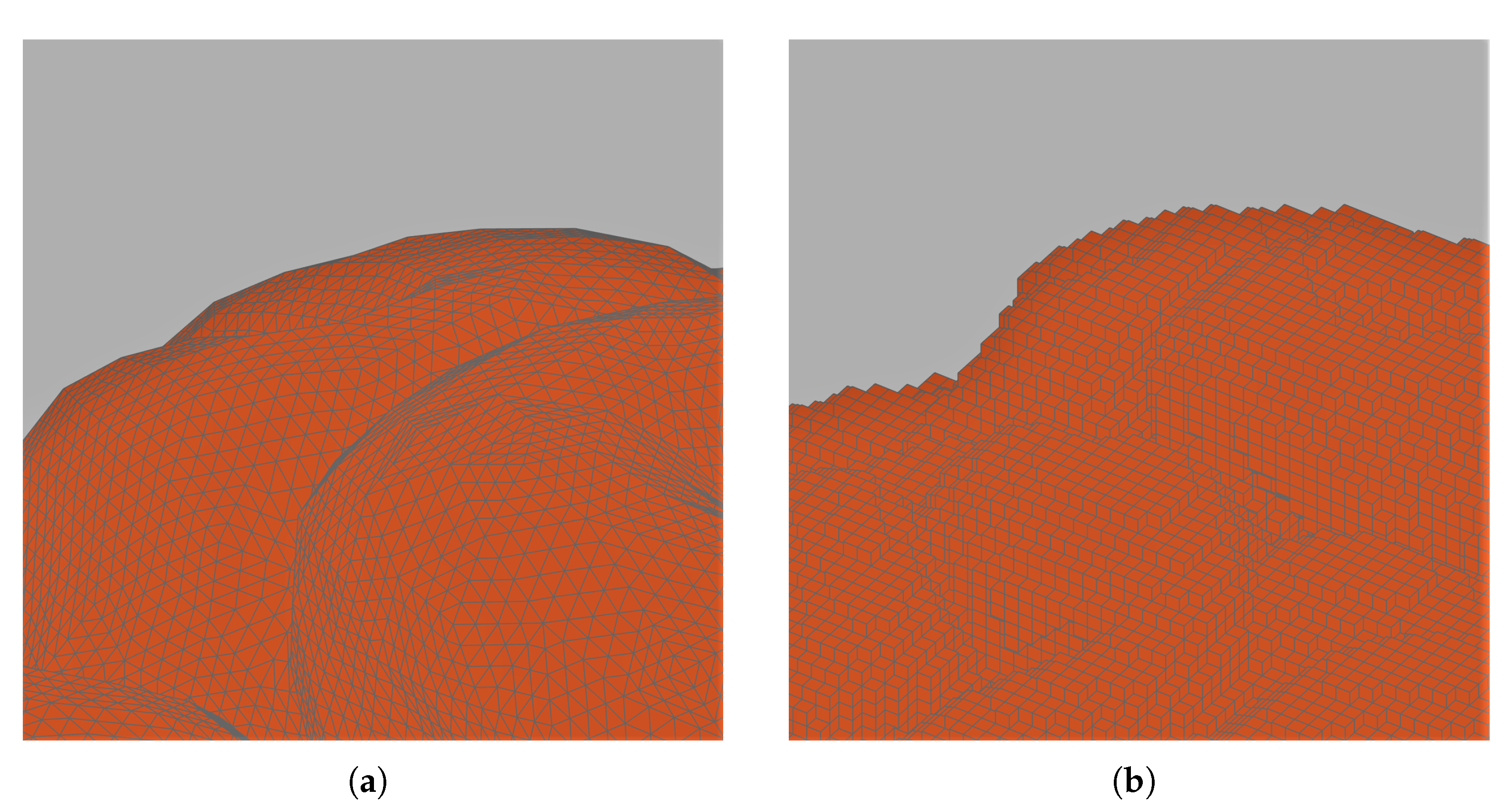

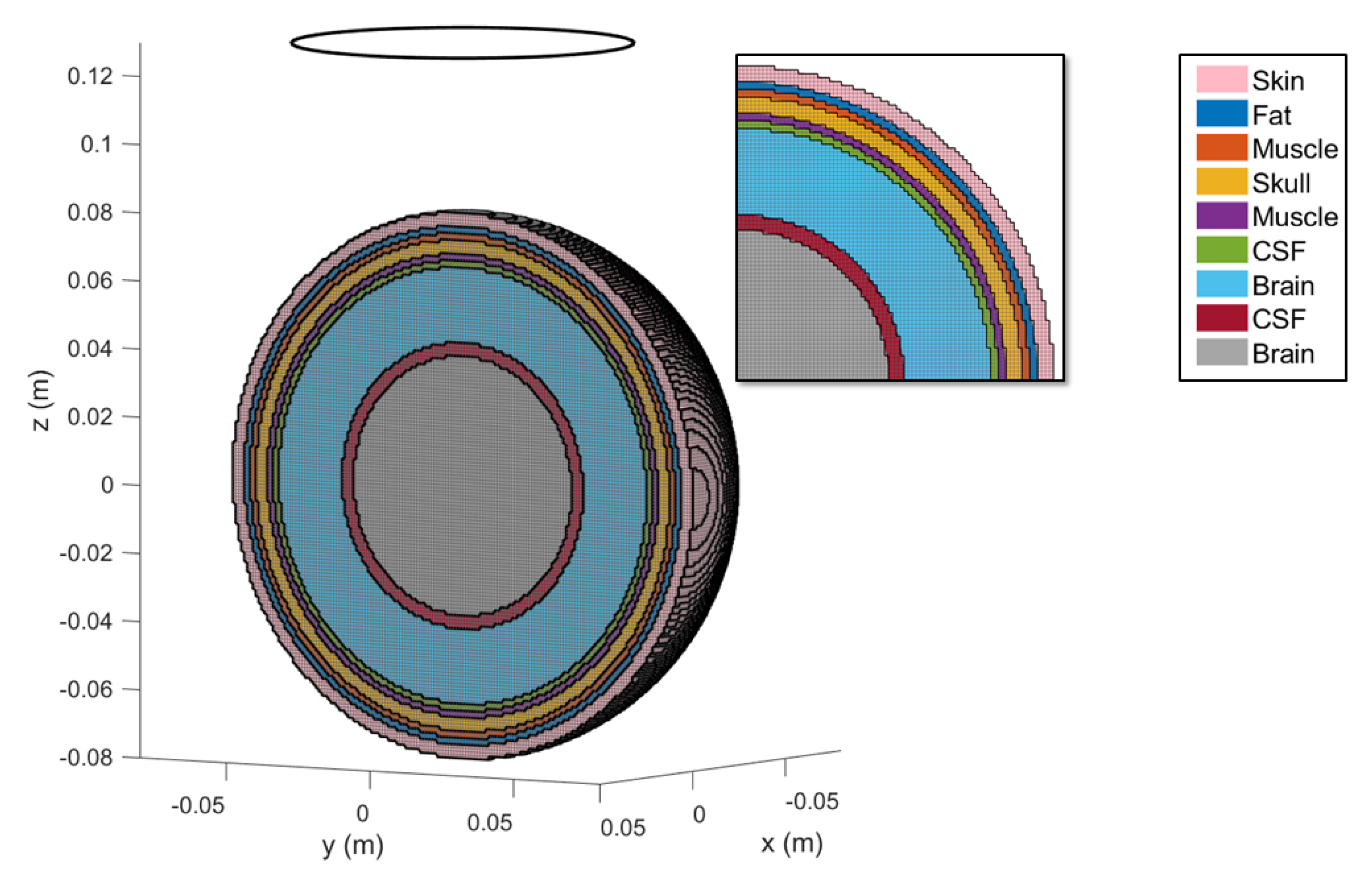

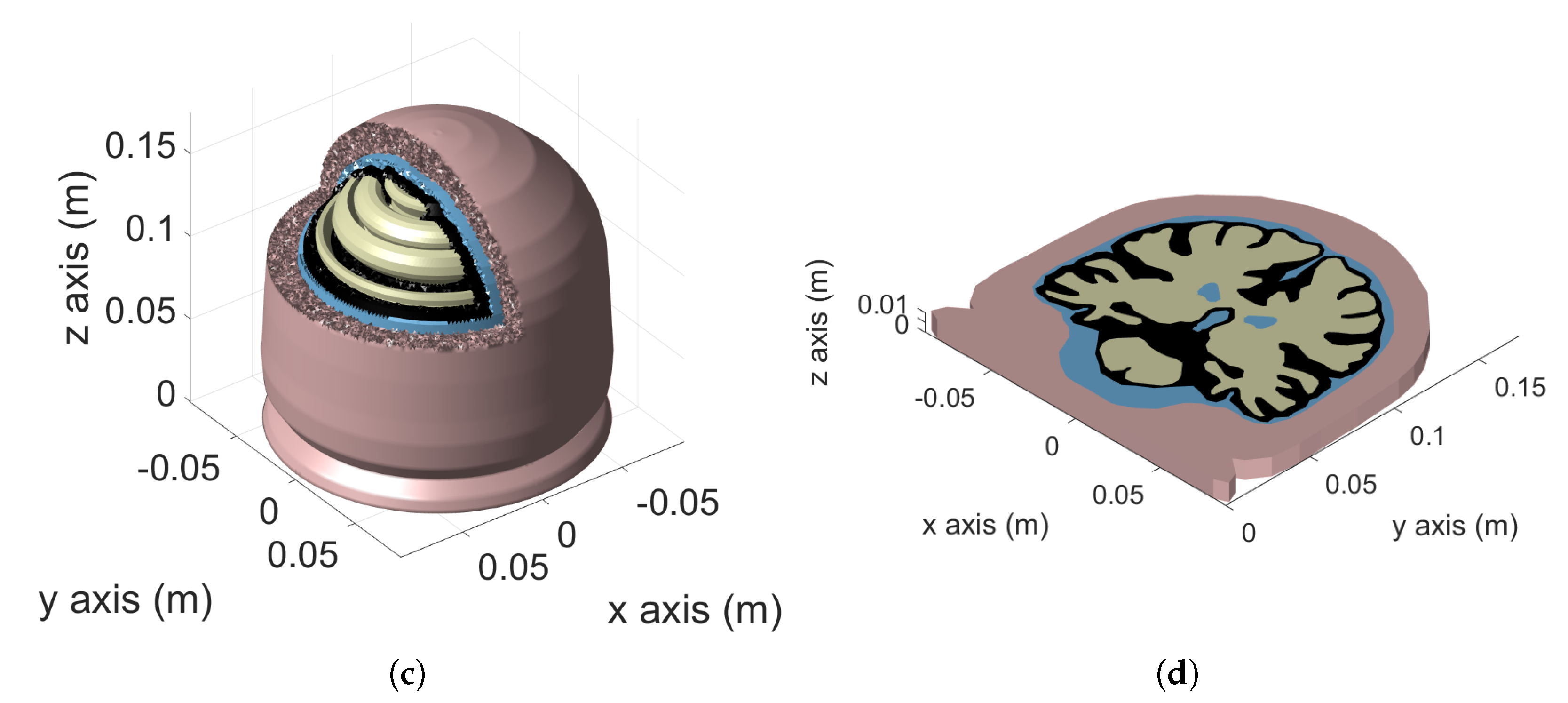
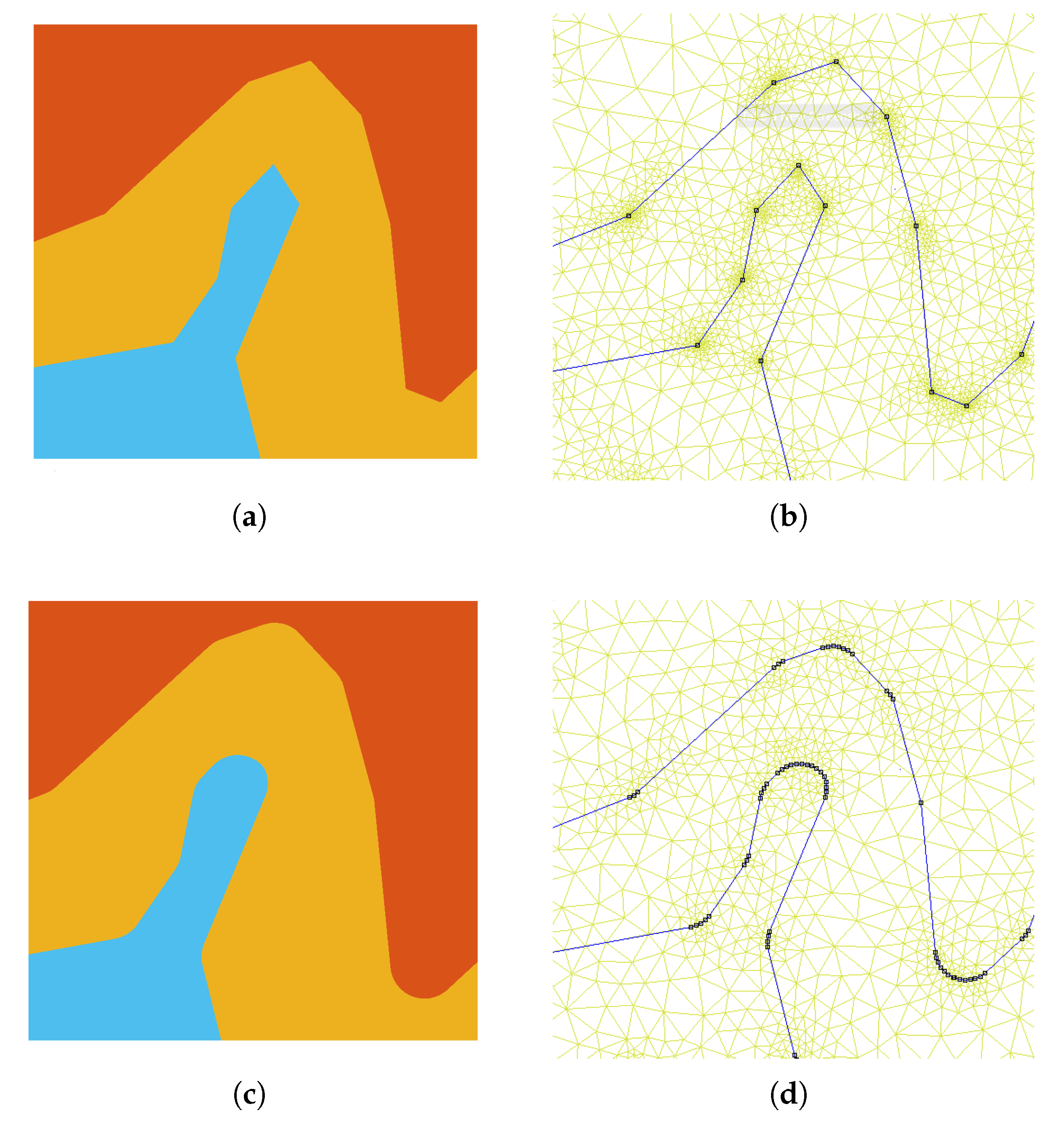
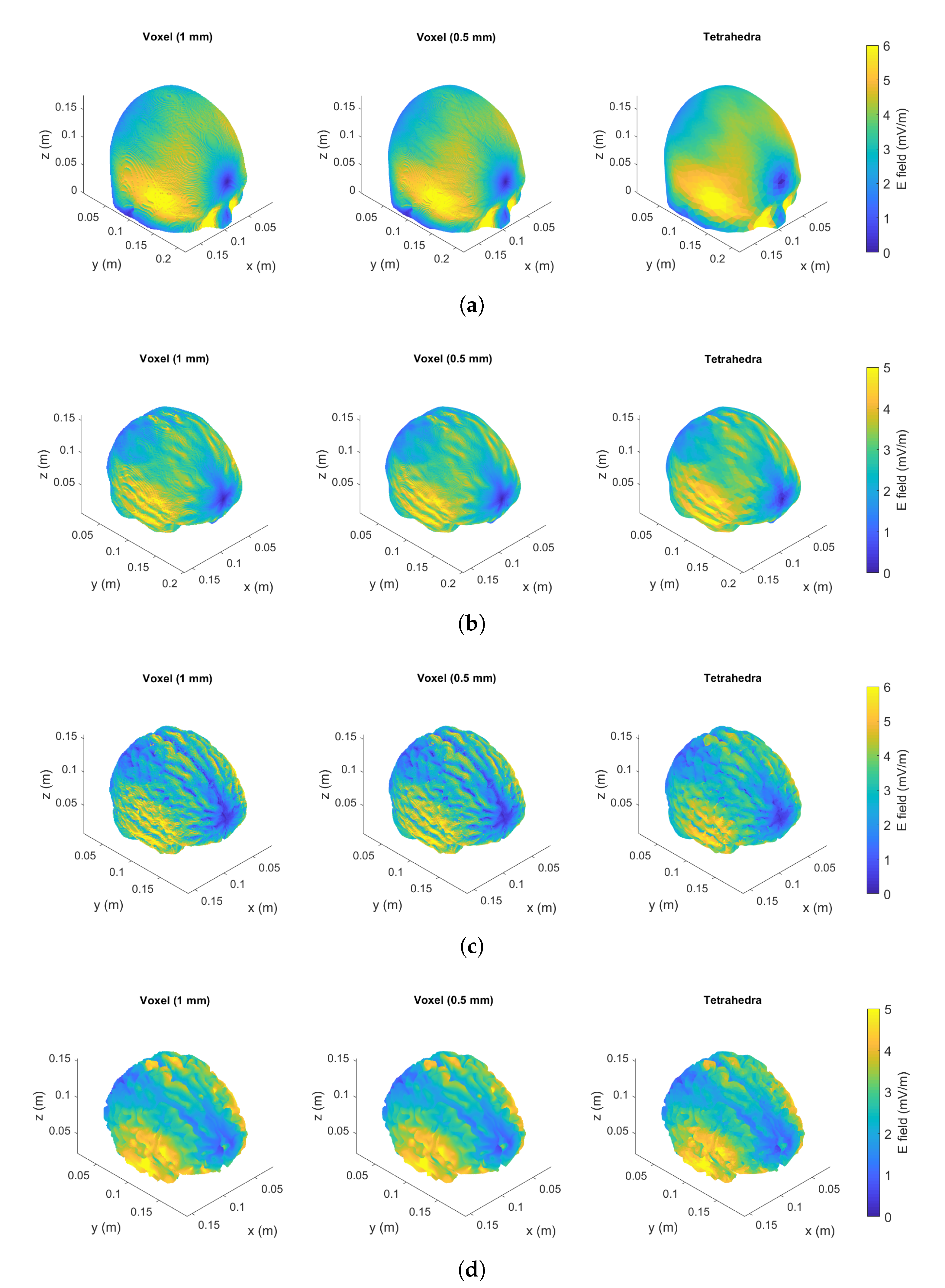
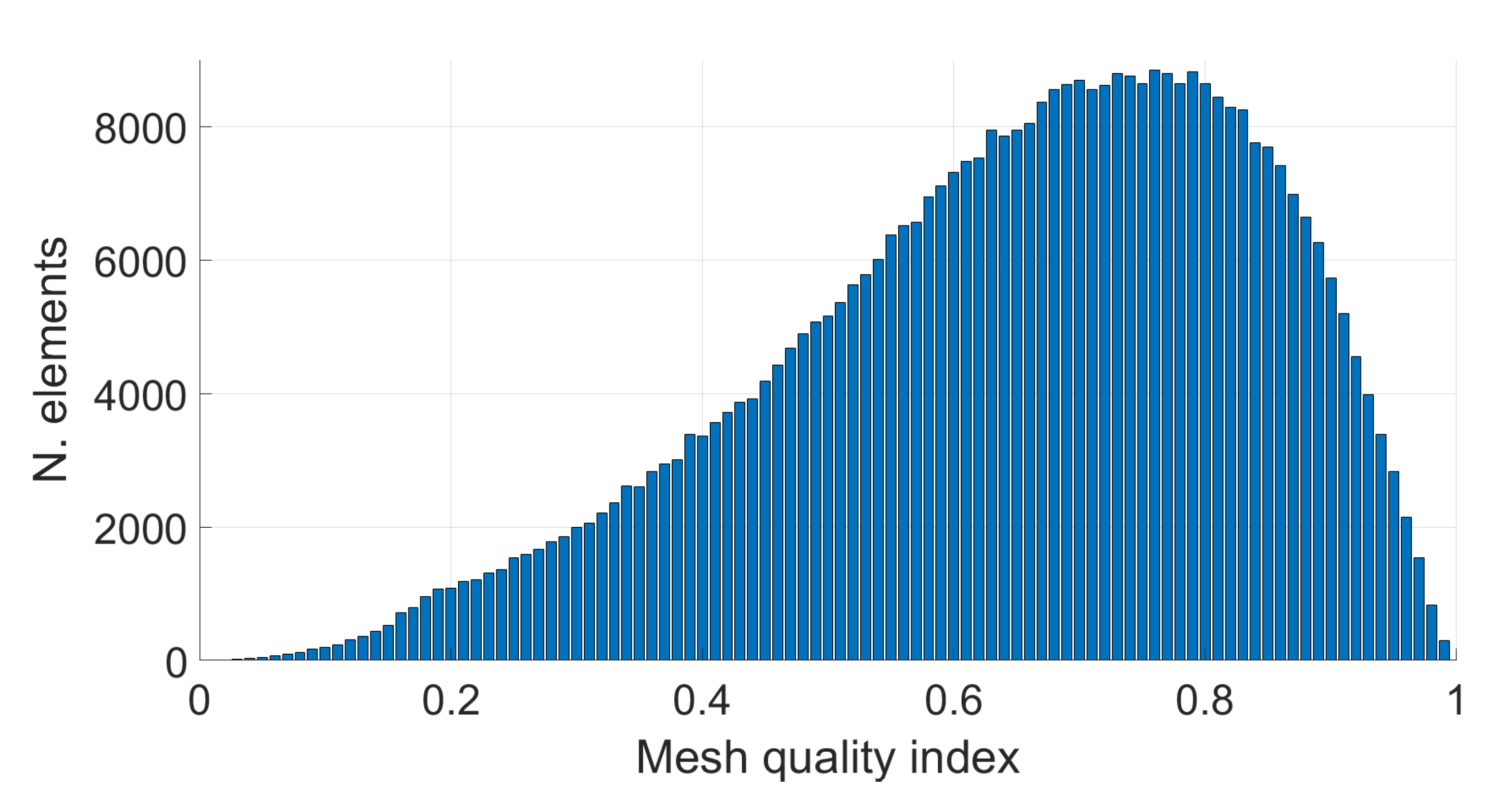
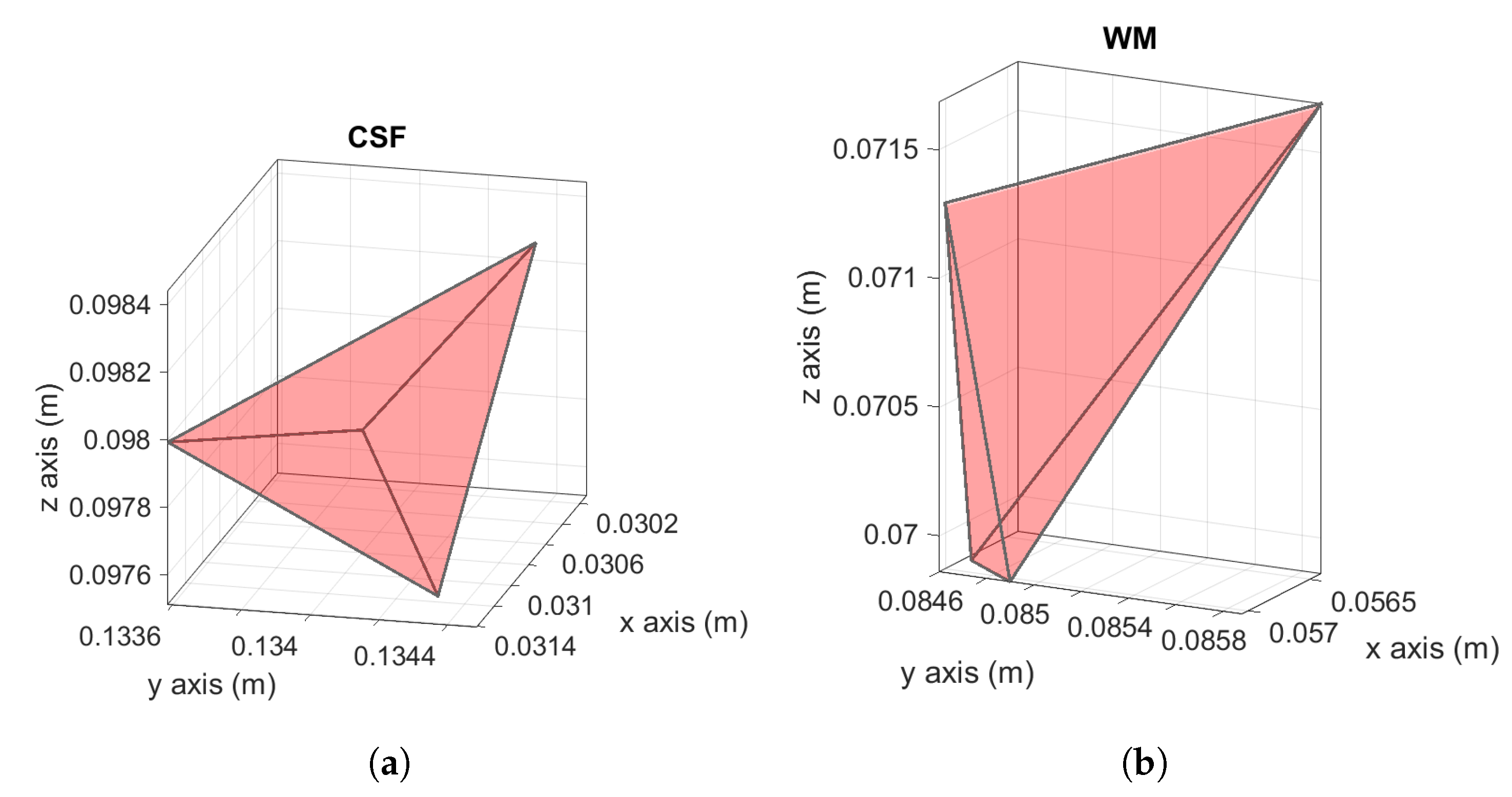
| Layer | Tissue | Radius (mm) | Conductivity (S/m) |
|---|---|---|---|
| 1 | Skin | 80 | |
| 2 | Fat | 76 | |
| 3 | Muscle | 74 | |
| 4 | Skull | 72 | |
| 5 | Muscle | 68 | |
| 6 | Cerebrospinal fluid | 66 | |
| 7 | Brain | 64 | |
| 8 | Cerebrospinal fluid | 42 | |
| 9 | Brain | 38 |
| Tissue | Analytical | Voxel 1 mm | Tetra | ||
|---|---|---|---|---|---|
| Solution | Max | 99.9th | 99th | Max | |
| (mV/m) | |||||
| Skin | 16.38 | 1.1563 | 1.0534 | 0.9844 | 1.0051 |
| Fat | 14.37 | 1.1104 | 1.0804 | 1.0265 | 1.0050 |
| Muscle | 13.47 | 1.1344 | 1.0618 | 1.0114 | 1.0034 |
| Skull | 12.63 | 1.2132 | 1.1223 | 1.0192 | 1.0026 |
| Muscle | 11.11 | 1.1524 | 1.0910 | 1.0294 | 1.0041 |
| CSF | 10.40 | 1.1836 | 1.0916 | 1.0187 | 1.0051 |
| Brain | 9.78 | 1.2699 | 1.0971 | 0.9373 | 1.0022 |
| CSF | 4.76 | 1.1721 | 1.1001 | 1.0016 | 0.9988 |
| Brain | 4.12 | 1.2389 | 1.1284 | 0.9878 | 1.0015 |
| Tissue | Reference | Voxel 1 mm | Voxel 0.5 mm | Tetra | ||||
|---|---|---|---|---|---|---|---|---|
| 2D | Max | 99.9th | 99th | Max | 99.9th | 99th | Max | |
| (mV/m) | ||||||||
| Skull | 2.79 | 1.372 | 1.149 | 1.018 | 1.263 | 1.111 | 0.994 | 1.002 |
| CSF | 2.31 | 1.484 | 1.208 | 1.100 | 1.283 | 1.152 | 1.062 | 1.003 |
| Grey Matter | 2.26 | 1.509 | 1.279 | 1.110 | 1.438 | 1.225 | 1.050 | 1.001 |
| White Matter | 2.12 | 1.025 | 1.002 | 0.975 | 1.010 | 0.998 | 0.975 | 1.003 |
| Tissue | Reference | Voxel 1 mm | Voxel 0.5 mm | Tetra | ||||
|---|---|---|---|---|---|---|---|---|
| 2D | Max | 99.9th | 99th | Max | 99.9th | 99th | Max | |
| (mV/m) | ||||||||
| Skull | 6.89 | 1.086 | 0.854 | 0.596 | 1.053 | 0.738 | 0.564 | 1.092 |
| CSF | 6.19 | 1.004 | 0.986 | 0.623 | 1.039 | 0.866 | 0.671 | 1.098 |
| Grey Matter | 11.06 | 0.805 | 0.694 | 0.500 | 0.769 | 0.610 | 0.452 | 0.934 |
| White Matter | 4.68 | 1.045 | 0.978 | 0.894 | 1.018 | 0.925 | 0.843 | 1.006 |
| Tissue | Max Value | 99.9th | 99th | ||||||
|---|---|---|---|---|---|---|---|---|---|
| Voxel | Tetra | Voxel | Tetra | Voxel | Tetra | ||||
| 1 mm | 0.5 mm | 1 mm | 0.5 mm | 1 mm | 0.5 mm | ||||
| Skull | 12.12 | 10.49 | 6.59 | 4.21 | 4.17 | 3.72 | 3.51 | 3.47 | 3.29 |
| CSF | 6.07 | 6.92 | 4.91 | 3.94 | 3.74 | 3.72 | 3.19 | 3.17 | 3.25 |
| GM | 12.09 | 14.11 | 8.12 | 4.97 | 5.05 | 5.04 | 3.69 | 3.63 | 3.72 |
| WM | 6.58 | 9.86 | 4.83 | 3.40 | 3.31 | 3.39 | 2.84 | 2.79 | 2.90 |
| Tissue | Max Value | 99.9th | 99th | ||||||
|---|---|---|---|---|---|---|---|---|---|
| Voxel | Tetra | Voxel | Tetra | Voxel | Tetra | ||||
| 1 mm | 0.5 mm | 1 mm | 0.5 mm | 1 mm | 0.5 mm | ||||
| Skull | 16.95 | 17.23 | 10.45 | 8.30 | 8.29 | 6.93 | 6.02 | 6.01 | 5.44 |
| CSF | 9.30 | 11.97 | 12.38 | 5.99 | 5.85 | 5.88 | 4.87 | 4.85 | 5.10 |
| GM | 17.05 | 23.94 | 17.70 | 8.07 | 8.17 | 9.10 | 5.91 | 5.82 | 5.94 |
| WM | 11.63 | 17.10 | 30.14 | 5.67 | 5.55 | 5.62 | 4.72 | 4.64 | 4.81 |
Publisher’s Note: MDPI stays neutral with regard to jurisdictional claims in published maps and institutional affiliations. |
© 2022 by the authors. Licensee MDPI, Basel, Switzerland. This article is an open access article distributed under the terms and conditions of the Creative Commons Attribution (CC BY) license (https://creativecommons.org/licenses/by/4.0/).
Share and Cite
Conchin Gubernati, A.; Freschi, F.; Giaccone, L.; Scorretti, R. Analysis of Numerical Artifacts Using Tetrahedral Meshes in Low Frequency Numerical Dosimetry. Appl. Sci. 2022, 12, 6526. https://doi.org/10.3390/app12136526
Conchin Gubernati A, Freschi F, Giaccone L, Scorretti R. Analysis of Numerical Artifacts Using Tetrahedral Meshes in Low Frequency Numerical Dosimetry. Applied Sciences. 2022; 12(13):6526. https://doi.org/10.3390/app12136526
Chicago/Turabian StyleConchin Gubernati, Alice, Fabio Freschi, Luca Giaccone, and Riccardo Scorretti. 2022. "Analysis of Numerical Artifacts Using Tetrahedral Meshes in Low Frequency Numerical Dosimetry" Applied Sciences 12, no. 13: 6526. https://doi.org/10.3390/app12136526
APA StyleConchin Gubernati, A., Freschi, F., Giaccone, L., & Scorretti, R. (2022). Analysis of Numerical Artifacts Using Tetrahedral Meshes in Low Frequency Numerical Dosimetry. Applied Sciences, 12(13), 6526. https://doi.org/10.3390/app12136526








